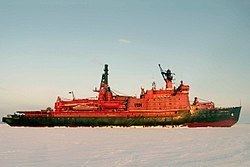Operator Atomflot Completed 25 April 1975 Tonnage 18,172 GRT Length 148 m Draft 11 m | Out of service 2008 Launched 26 December 1972 Weight 23,460 tons Beam 30 m | |
 | ||
Builders Baltic Shipyard, Saint Petersburg | ||
NS Arktika (Russian: «Арктика»; [ˈarktʲɪkə]) is a retired nuclear-powered icebreaker of the Soviet (now Russian) Arktika class. In service from 1975 to 2008, she was the first surface ship to reach the North Pole, a feat achieved on August 17, 1977. Arktika required refuelling every three and a half years.
Construction of the ship began in the Baltic Shipyard in Leningrad on July 3, 1971. Sea trials completed successfully on December 17, 1975. For further information on the ship's design, construction and propulsion system, see Arktika class icebreaker.
In 1982, she was rechristened Leonid Brezhnev in honour of Leonid Brezhnev, the General Secretary of the Central Committee of the Communist Party of the Soviet Union from 1964 until his death in 1982. In 1986 the name reverted to Arktika, according to some accounts because the ship's crew disliked the new name and refused to respond to radio messages unless the ship was referred to as Arktika. Within a week of the strike, the name was changed back. Another explanation is that the original name change had been due to an administrative mixup, and the name Leonid Brezhnev had never been supposed to apply to Arktika at all, but had been intended for a different ship.
Arktika was retired for several years, but was repaired in the late 1990s.
Originally designed for 100,000 hours of reactor life, Arktika's service life was prolonged another 50,000 hours in 2000, and another 25,000 hours after that, adding eight years to a 25-year planned service life. The life extension was accomplished by means of replacing critical equipment to allow the safe and continued operation of the nuclear plant. On May 17, 2000, a conference of Russian engineers, scientists, and government officials took place on board Arktika after her first service extension. The extension cost only $4 million, compared to the $30–50 million cost of a new nuclear icebreaker, and proved to be a successful endeavor. The conference concluded thus that the lifetimes of Russian nuclear icebreakers could be successfully extended to 175,000 hours, and possibly more.
On April 9, 2007 a fire broke out on Arktika. The fire caused minor damage to three cabins and knocked out an electricity-distribution panel. The nuclear reactor was not damaged. There were no injuries. The icebreaker was in the Kara Sea when the blaze erupted, and was sent to Murmansk.
After 33 years of reliable icebreaking, having become the first surface ship to reach the North Pole in 1977, and the first civilian ship to spend more than a year at sea without making port in 2000, and covering more than a million nautical miles by 2005, Arktika was retired in October 2008. She is docked at Atomflot, the nuclear base and dock in Murmansk, 1 ½ km (0.9 miles) away from the main docks, where she will remain until policies can be drawn up to dismantle her. In the meantime, she is a subject of important research, focused mainly on how to further extend the service life of the other Arktika-class icebreakers. There have been calls for the ship to be converted to a museum, either in Murmansk or St. Petersburg. An earlier Soviet nuclear icebreaker, Lenin, is already a museum ship in Murmansk.
